 |
 |
2015 |
30 August 2015
At Schiphol we have all the time in the world before the departure
of our 12:30
Easy Jet flight to
Dubrovnik.
We have reserved seats on the exit row. The aircraft is almost full at
departure. We arrive in Dubrovnik at 2:30pm . From the air, we already see
the old town. We are picked up by Robi, the owner of our apartment that we
found on
Airbnb. He
is a few minutes late, but he's forgiven. It is a 20 minutes' drive to the
apartment. It sits above the old town with a beautiful view from the
terrace. Modern furnishings. We want to go shopping for groceries, but the
supermarket nearby is closed on Sundays. Therefore, we have to walk to the
Pile Gate, where there is sufficient supply. We have a drink on a terrace.
At a Tisak kiosk I buy a SIM card from VIPnet that offers seven times 1GB of
data per day. All for just 15 euros. We take bus line #3 back to the
apartment, because otherwise it would be quite a climb in the summer
heat. The bus does take a huge detour of about fifteen minutes. At half past
five we go down again. We drink a cocktail on the Stradun. It's pretty
crowded at this hour. At half past seven we have reserved at
Gil’s little bistro
on a side street of the Stradun. Excellent restaurant and friendly service.
Erik takes carpaccio and steak and I had a tuna tartare followed by a shark
fillet. Coffee after. Then we walk to the bus station and take the bus to
the top. We enjoy a bit of the evening on our balcony.
Weather: sunny 30ºC / 86ºF
Monday 31 August 2015
We get up early
to
beat the worst of the heat. We have breakfast in our apartment and walk down
the stairs to the Pile Gate. Here is the entrance for the walk over the city
wall. The walls are still or again completely in tact. The oldest parts date
from the 10th century, but most dates from the 16th century. First we have
to do some stiff climbing. From the entrance a steep staircase leads up
to the top of the wall. The view of the old city is beautiful. Especially
the many red roofs. There is one-way traffic on the wall going counter
clockwise. We walk towards the sea and and it again goes up considerably.
The street plan of Dubrovnik adheres to a rigid grid and from the wall we
can look into the narrow streets until the middle of the city. We pass the
old harbor and then some steps up along the land side. The walk takes us a
bit over an hour. We are happy that we do it early, because it's quiet and
not too hot. After the tour we enjoy a drink fresh in a side street. We
start with a walk through the old city. We start at the Franciscan monastery
with its ancient pharmacy from the 13th century, perhaps the oldest in
Europe. In front of the monastery is the large fountain of Onofrio, where
visitors had to wash in the
Middle
Ages in on account of the plague. Then we continue along Stradun and where
we turn left into a narrow street. We drink coffee and visit the
War Photo
exhibitions. There are exhibitions on the 1st floor (this time Central
African Republic) and upstairs a permanent one on the siege of Dubrovnik
late 1991. Impressive. Much was bombed during the siege and destroyed in the
fire.
We continue our way on the Perijako, a street higher up parallel to the
Stradun. Here are numerous restaurants, all of them tourist traps. We turn
right to the
Stradun
passing the synagogue. On the Stradun we walk to another large square, the
Luza, where the clock tower is. Flanking the clock are two bronze figures
who strike the bells. Next to an old clock the tower holds also a
digital clock. We walk towards the Ploce gate. From there you have beautiful
view of the city. We sit down again for something to eat and drink at
Revelin.
We walk back into town and then along the Rector's Palace. This was the seat
of the rector (president) of Ragusa, the independent mediaeval republic and
of all other public agencies. A bit further down is the Cathedral. A
relatively simple Baroque church. It replaces an older Romanesque original
which was destroyed during the earthquake of 1667. Through the Od Puca
street we walk past the Orthodox Church towards the Pile gate. Here we take
the
bus back to the apartment.
Later in the afternoon we take the bus no. 5 to the base station of the
cable car. The original
ropeway of 1969 did not survive the Yugoslav war. I was up there in 1987.
Now there is a brand new copy, which brings us to the top. From the top we
have a beautiful view of Dubrovnik, the island Lokrum and the anchored
cruise ships. From the base station walk back down to the old town. We have
a drink at the Troubadour Jazz Café. Then we eat outside the old town at
restaurant
Sesame. On a rooftop, we
sit beautifully, but there is a lot of traffic noise from the busy road to
and from the Pile gate. I take the bream, Erik Gazpacho and beef. After dinner
we go with no. 3 bus back up to the apartment.
Weather: 35ºC / 95ºF, sunny
Tuesday 1 September 2015
After breakfast we go down
the stairs to the Pile gate. We drink coffee just outside the gate and walk
through the old town to the harbor. We want to take the boat to the island
of Lokrum, but just missed the 9am crossing. We have to wait almost an hour.
We do this at a posh side walk café next to the Rector's Palace. We are on
time for the 10 'o clock service to Lokrum. The boat almost fully occupied
when it sails to the island. Within 10 minutes we are there. From the jetty
we keep left and after a few minutes we are on a rocky beach. Around this
time, there is hardly a spot in the shade. The sun is right on beach and we
have no umbrella. This limits the selection for a spot to the parts shaded
by trees. We get ourselves installed and make our way over the rocks and a
ladder into the water. It's delicious. From tim
e
to time tour boats pass along. Groups of sea kayaks too. The beach gets
filled with sunbathers and around half past eleven the beach bar opens
up. The sun climbs higher and the is shades get longer. Around 13 o'clock we
go to the snack bar Lacrom
a
a little further up and eat a sandwich. We walk to the ruins of a
Benedictine monastery and chapel. These were converted in the 19th century
into a summer residence for Maximilian of Austria, who became later Emperor
of Mexico. In a coup in 1867 he was executed there. It's far too hot to
explore the island much further. We take the boat back at 1.45pm to the port
of Dubrovnik. With bus no. 3 we go back to the apartment. By 6 o'clock we go
back into the city. We eat at a very simple pizzeria called Petica 5. Simple
but tasty. After that we drink coffee and a beer on the terrace bar Kase and
Mirage bar, respectively. We take the bus back to our appartment. We unwind
on the terrace and then to bed.
Weather: sunny and 32°C / 90ºF
Wednesday 2 September 2015
Dubrovnik - Split: 229km (142 mi)
After breakfast we go down the stairs to the old town. We drink coffee at cafe Slinka again. Then we walk to the Hilton Hotel, which has a branch of Sixt rent a car. We're too early. The car was ordered for 10am and it's not even nine o'clock. After about 10 minutes we get a call that they have a car ready for us. It's an upgrade. We get an Opel Zafira. It is not entirely clean. We are heading towards Split and after more than an hour of driving along the Dalmatian coast overlooking numerous islands, we arrive at the border with Bosnia and Herzegovina. That country has a small coastal strip of about 11 kilometers, cutting the Croatian coastal area of Dalmatia into two pieces. Croatia is not entirely happy with that, but it is a legacy of the Yugoslav period. Sixt has provided us with the green insurance card for the car, which means we are allowed to cross the border with it. After 11 km we enter again into Croatia. The road takes us now further inland and after about a hundred km, the two lane road turns into a motorway with toll. After three hours in total we arrive in Split.
We called Petar, the owner of our apartment, which we again found through
Airbnb, and he is waiting for us at the Riva boulevard. He guides us to a
parking space, he has arranged through a friend. Parking spaces are
extremely rare in the center of Split. The old town is even car-free. From
there we walk with him to the apartment inside the remains of the Roman
palace of former Emperor Diocletian. The room has not been cleaned yet. We
leave the suitcases and go out to lunch. Petar brings us the keys at the
restaurant. After lunch we go shopping for groceries at a nearby
supermarket.
Later in the
afternoon
we drive up to Trogir,
which is a little over half an hour from Split, near the airport. On
the way to Trogir our car warns us constantly that we are out of
AdBlue. We did not know what it is, but a google search shows that it
is an auxiliary liquid that enhances the the combustion of the diesel
and reduces the toxic exhaust fumes. The car's warnings are getting
more frequent by the minute, so we decide to stop at a gas station to
buy a jerry can of the stuff. 80 kuna gets us 10 liters, which
almost fits entirely into the separate tank. Then we can continue
peacefully. Trogir is a beautiful and historic walled Venetian town
with beautiful churches and a nice harbor. The old town is on an
island, which is separated by a canal from the mainland. We walk to go
and watch the St Lawrence's Church and have a drink around there on a
terrace. Opposite the church is the city hall as well as a Venetian
Loggia. The Venetian
lion was blown away from the facade in a nationalist attack in 1932.
Through the Gradska Ulica we walk to the seafront while passing the St
Nicholas monastery. There is a gate in the city wall which gives access to a
boulevard, where tour boats are moored. Tenders come and go here, bringing
cruise passengers to and from the city. We walk along the boulevard to the
Kamerlengo fortress, named after the Venetian official (the Kamerling), who
once controlled Trogir on behalf of Venice. We walk around it to the
Glorietta, made for the French governor during the Napoleonic era, Marmont.
This is ugly daubed with graffiti. We walk
through the narrow streets of the city back to the car. After visiting
Trogir, we drive back and Garmin leads us easily back to the parking space
in Split.
At night we eat at Hvaranin, a simple fish restaurant just outside the old town. After dinner we drink coffee on the Riva, which is hiving with all kinds of activity. Then to the apartment. Here we wind down on tiny our balcony. It is quite hot because the balcony overlooks a very large courtyard where dozens of air conditioners blow their hot air into. In our bedroom it is hard to ignore the street noise despite, the double glazed windows. Earplugs do help and after midnight it becomes more or less peaceful.
Weather: Sunny 35°C / 95ºF.
Thursday 3 September 2015
We get up around 7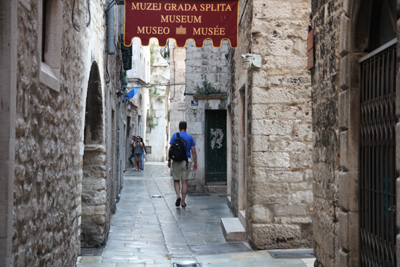 am and have breakfast in our apartment. After breakfast we walk to the car.
It is still very quiet on the streets and you can even take pictures without
other people in it. We drive the car to the city location of Sixt. As the
crow flies it is not far away, but because of one-way traffic and pedestrian
areas it is over 3km away. We return the car and walk to the Riva, where we
drink a cappuccino. We take a taxi to the lookout Telegrin on the Marjan
Hill. But we do not get that far because the upper part of the hill is
closed to cars. We have to walk 600 meters uphill and that is too much in
this heat. We therefore go down to Vidilic cafe on the edge of the Jewish
cemetery, which also has a beautiful view of the city, but at a somewhat lower vantage point.
We have a drink here and take pictures.
am and have breakfast in our apartment. After breakfast we walk to the car.
It is still very quiet on the streets and you can even take pictures without
other people in it. We drive the car to the city location of Sixt. As the
crow flies it is not far away, but because of one-way traffic and pedestrian
areas it is over 3km away. We return the car and walk to the Riva, where we
drink a cappuccino. We take a taxi to the lookout Telegrin on the Marjan
Hill. But we do not get that far because the upper part of the hill is
closed to cars. We have to walk 600 meters uphill and that is too much in
this heat. We therefore go down to Vidilic cafe on the edge of the Jewish
cemetery, which also has a beautiful view of the city, but at a somewhat lower vantage point.
We have a drink here and take pictures.
We descend back to the city via a staircase. We eat sandwiches at Popaj
deli and take a coffee on the roof of a department store before we go to the
Split Art Gallery (Galleria umjenina). A collection of
Croatian art from
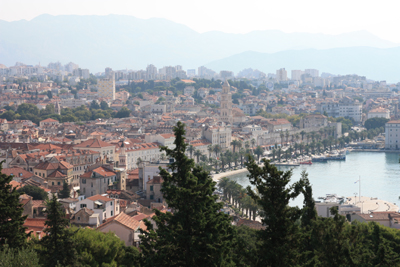 the
Middle Ages to the present day. The collection started in 1908 with a
donation of modern art by the governor of Dalmatia. The collection grew
through donations, bequests and purchases and gives a good overview of
artistic development in Croatia. It looks like modern art was not kept on a
short leish in the communist e
the
Middle Ages to the present day. The collection started in 1908 with a
donation of modern art by the governor of Dalmatia. The collection grew
through donations, bequests and purchases and gives a good overview of
artistic development in Croatia. It looks like modern art was not kept on a
short leish in the communist e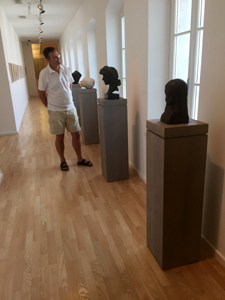 ra
and the arts have followed the European developments. Here and there we also
see some foreign artists among the works displayed. Like an etching by
Albrecht Dürer and a drawing / preliminary study by Egon Schiele. Since 2001
the museum is housed in a former hospital building dating back from 1792.
ra
and the arts have followed the European developments. Here and there we also
see some foreign artists among the works displayed. Like an etching by
Albrecht Dürer and a drawing / preliminary study by Egon Schiele. Since 2001
the museum is housed in a former hospital building dating back from 1792.
Around half past six we go out for a drink. We drink an Aperol Spritz at La
Bodega and then another at Ghetto. The latter is an artistic joint with nice
courtyard. There is a live pianist and it is visited by many trendy types.
We dine at Paradigma, on the
rooftop terrace overlooking the harbor. It is a quality restaurant. Erik
takes a tartare of rib-eye, followed by veal cheek. I take a "napkin" of
cuttlefish and then a Croatian ray. For dessert Erik takes a collection
Sorbets and for me there is a Flan Catalan. Delicious Croatian wine to go
with it. A Stina Jako Vino from the island of Brac. Made from the Dalmatian
Vugava grape. We wander back to the apartment.
Weather: 31 degrees and lots of sunshine.
Weather: 31ºC / 88ºF and lots of sun.
Friday 4 September 2015
After bre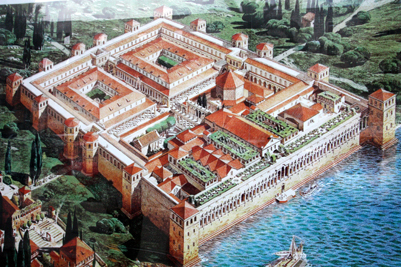 akfast,
we drink coffee at the Narodni square at Kavana Central. When we order only
coffee, the waiter's spirit drops a few notches, even though the terrace is as good as
empty. Apparently our money is not very welcome. Back to the room and wait
until it is half past nine. That is when
Miloš
Grkinic is ready to guide us through the old town. We found him through
Tours by Locals. He shows us
all corners of Diocletian's Palace and the old city that lies around it. We
start at the Narodni Square where we come through the bronze gate. Then we
go through the underpass to the waterfront, the Riva. This was the access
from the sea to the warehouses of Diocletian's Palace. Diocletian was Roman
emperor at the end of the 3rd century and the only emperor who voluntarily
resigned and withdrew to his birth place to go gardening. We continue to the
market at the Silver Gate. Here we go again into the palace. We walk to the
former mausoleum of the emperor, in which he was buried, but from which his
remains vanished after 170 years. Later it became the ca
akfast,
we drink coffee at the Narodni square at Kavana Central. When we order only
coffee, the waiter's spirit drops a few notches, even though the terrace is as good as
empty. Apparently our money is not very welcome. Back to the room and wait
until it is half past nine. That is when
Miloš
Grkinic is ready to guide us through the old town. We found him through
Tours by Locals. He shows us
all corners of Diocletian's Palace and the old city that lies around it. We
start at the Narodni Square where we come through the bronze gate. Then we
go through the underpass to the waterfront, the Riva. This was the access
from the sea to the warehouses of Diocletian's Palace. Diocletian was Roman
emperor at the end of the 3rd century and the only emperor who voluntarily
resigned and withdrew to his birth place to go gardening. We continue to the
market at the Silver Gate. Here we go again into the palace. We walk to the
former mausoleum of the emperor, in which he was buried, but from which his
remains vanished after 170 years. Later it became the ca thedral
of Split. Because the building was too small for a Bishop's church it was
expanded in the 17th century. We postpone the visit to the church on the
advice of Milos until later in the day, because it is very busy in the
morning hours. After the palace fell into disuse it was taken over by the
Dalmatians from the neighboring town of Salona, who built their houses
inside, especially along the walls of the palace. That saved them at least
one wall. These houses are now an obstacle for researchers, who cannot do
excavations under the foundations of these houses. The houses may not be
restored, because they are not part the world heritage, as UNESCO has
recognized it. So we have to wait until the houses finally collapse. Next to
the cathedral / mausoleum is perystilium, a (once) covered area surrounded
by columns. Here Diocletian held court. On the other side was the Jupiter
Temple, which was later converted into a baptistery. This also we will visit
later. We walk through the city on the main thoroughfare out to the Gold
thedral
of Split. Because the building was too small for a Bishop's church it was
expanded in the 17th century. We postpone the visit to the church on the
advice of Milos until later in the day, because it is very busy in the
morning hours. After the palace fell into disuse it was taken over by the
Dalmatians from the neighboring town of Salona, who built their houses
inside, especially along the walls of the palace. That saved them at least
one wall. These houses are now an obstacle for researchers, who cannot do
excavations under the foundations of these houses. The houses may not be
restored, because they are not part the world heritage, as UNESCO has
recognized it. So we have to wait until the houses finally collapse. Next to
the cathedral / mausoleum is perystilium, a (once) covered area surrounded
by columns. Here Diocletian held court. On the other side was the Jupiter
Temple, which was later converted into a baptistery. This also we will visit
later. We walk through the city on the main thoroughfare out to the Gold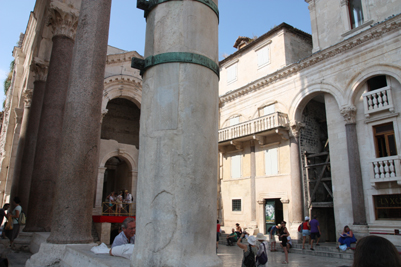 en
or north gate. Here we listen to a group of traditional Croatian singers. We
walk along the antiques market and the palace wall and get to the fish
market. Every day, the market place gets its fresh fish delivered. Friday is
a great day, because Catholics eat mostly fish on that day of the week. We
walk on to the administration building, the Prokure, that was built under
the Napoleonic occupation and administration. A very different style, French
Empire. We walk back to the Riva, making our way to a hidden cafe. It is not
on the promenade itself, but on the first floor and accessible via an
unobtrusive staircase and a closed door. Only local clients come here, to
get away from the tourists. The view of the harbor from here is beautiful.
We drink a coffee here. Then we walk once more to the Golden Gate and Miloš
tells about the statue of Gregory of Nin (Grgur Ninski) by Ivan Meštrović
from 1932. Gregory was bishop of Nin in the
en
or north gate. Here we listen to a group of traditional Croatian singers. We
walk along the antiques market and the palace wall and get to the fish
market. Every day, the market place gets its fresh fish delivered. Friday is
a great day, because Catholics eat mostly fish on that day of the week. We
walk on to the administration building, the Prokure, that was built under
the Napoleonic occupation and administration. A very different style, French
Empire. We walk back to the Riva, making our way to a hidden cafe. It is not
on the promenade itself, but on the first floor and accessible via an
unobtrusive staircase and a closed door. Only local clients come here, to
get away from the tourists. The view of the harbor from here is beautiful.
We drink a coffee here. Then we walk once more to the Golden Gate and Miloš
tells about the statue of Gregory of Nin (Grgur Ninski) by Ivan Meštrović
from 1932. Gregory was bishop of Nin in the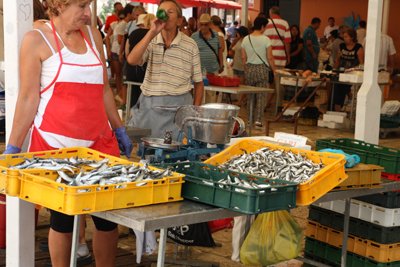 10th century, who opposed the papal authority and sought the introduction of
the national Croatian language in church services. That is the reason of his
fame and national adoration. At the time he got little support inside the
church. His diocese was abolished in 929. The sculpture was at first in the
Peristyle, but was removed as a precaution during the Italian occupation and
hidden from view. After the war it was placed outside the Golden gate,
because it was too much work to get him through the city gate. Touching the
big toe of the statue, makes the wish that you do come true. The toe shines
because of the many touches. The tour ends here and we say goodbye to Miloš.
10th century, who opposed the papal authority and sought the introduction of
the national Croatian language in church services. That is the reason of his
fame and national adoration. At the time he got little support inside the
church. His diocese was abolished in 929. The sculpture was at first in the
Peristyle, but was removed as a precaution during the Italian occupation and
hidden from view. After the war it was placed outside the Golden gate,
because it was too much work to get him through the city gate. Touching the
big toe of the statue, makes the wish that you do come true. The toe shines
because of the many touches. The tour ends here and we say goodbye to Miloš.
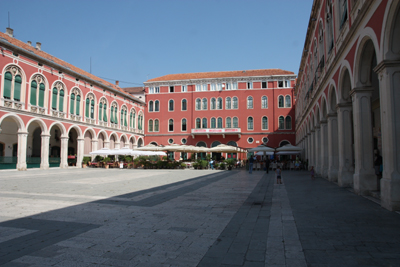
We will have lunch at Popaj again. Later we visit the Cathedral and
Baptistery. The cathedral is indeed very small, but it has beautiful altars.
Beneath it is a crypt, which is dedicated to St Lucia. This was used by the
early Christians. The Baptistery, has a sculpture of Meštrović, which
depicts John the Baptist. The baptismal font is from the 11th century.
Then we walk to the beach Bačvice. A fifteen minute walk from the apartment.
It lies around a small bay, and consists largely of concrete with a small
strip of sand in between. We rent chairs and umbrellas. It's not overly
crowded - at least not in the concrete part - and the water is fine for
swimming. The seabed is sandy and it is also nice. After a few hours
lounging and swimming we walk back.
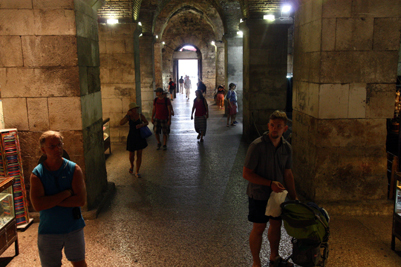
Around six o'clock we go out to drink a cocktail on the Riva (café Twins). We look at the stream of people passing by. It's been cloudy all day, but now the sky is really dark. When we decide to walk to our restaurant of choice the first drops start to fall. We almost make it to Bistro TOC dry. It is located just outside the old city. We get a seat on the covered terrace. The menu here is not the traditional fish and seafood, but also offers other choices. During dinner it starts to thunder and many are trying to find a safe haven on our terrace, but that is not possible because it is full. Around 8 pm we need to leave, because our table is reserved for other guests. Fortunately rain is dissipating. On the peristyle there is an open air concert going on.
Weather: cloudy, 24-29ºC. Evening thunderstorms, 25ºC.
Saturday 5 September 2015
After breakfast we go for a coffee on the Riva. It rains. We lounge around in the apartment, go back out for a walk and then back again. For we are picked up at 12.30 for our ride to the airport. Petar asked a friend to take us there. He accompanies us to the pickup location and waits for the car to arrive. The young man driving us, moonlights as a driver and gets us to the airport in just over half an hour. The airport is near Trogir. We are far too early. At the airport it is very crowded. The queues go well outside the departure hall. After more than 30 minutes we can check in. Then to the departure lounge. There is huge crowd here too. No seat is unoccupied and people sit on the stairs and on the ground. After a while we manage to get a seat. We still have to wait some time and the aircraft is delayed half an hour. The information is sparse. Once on board at Transavia everything goes smoothly and we are on schedule in Rotterdam. A taxi takes us home.
Weather: in Split rainy start. Warm, but cloudy. 25º / 77ºF.
|
|
Other Travel | |
| back |